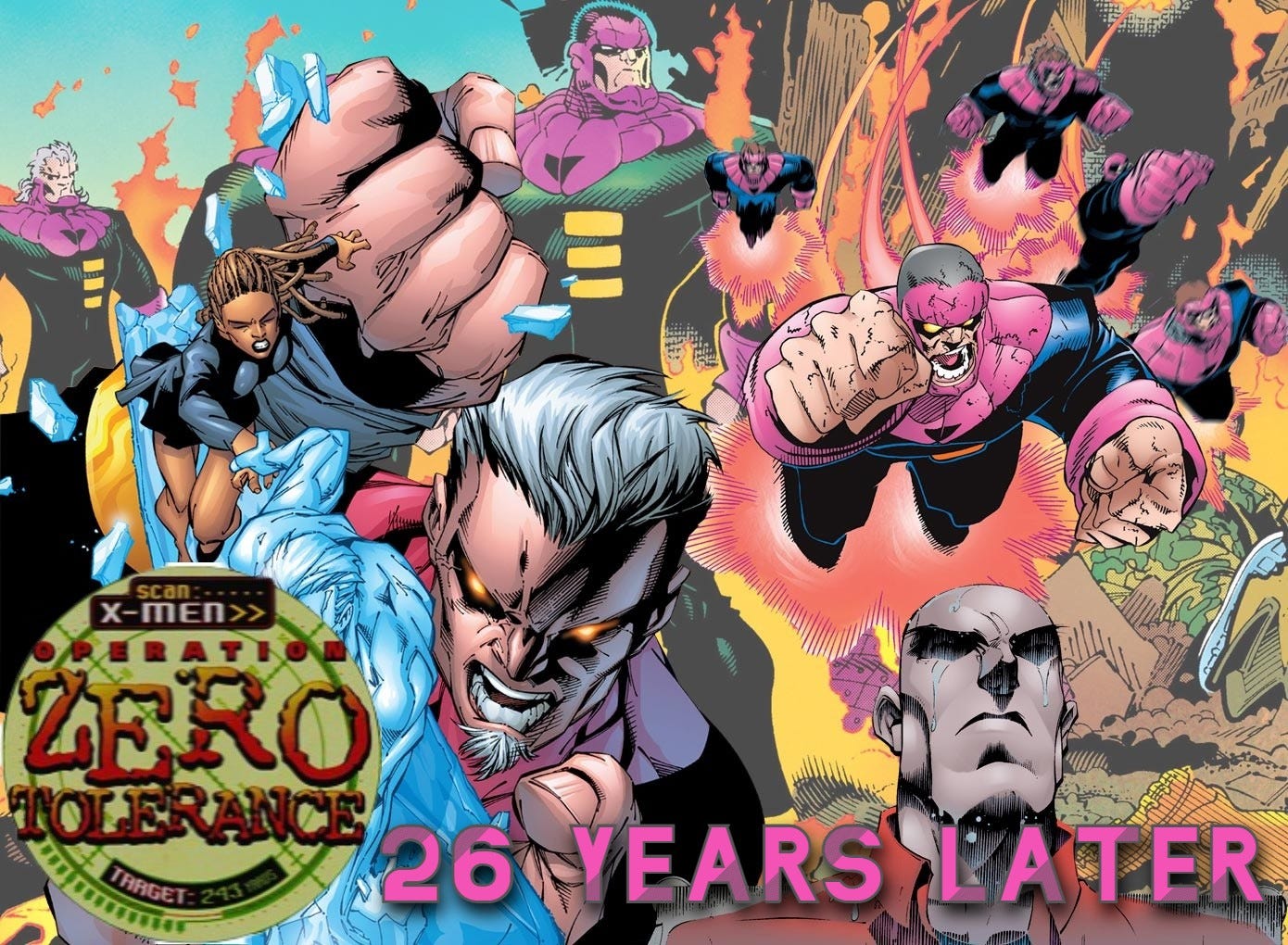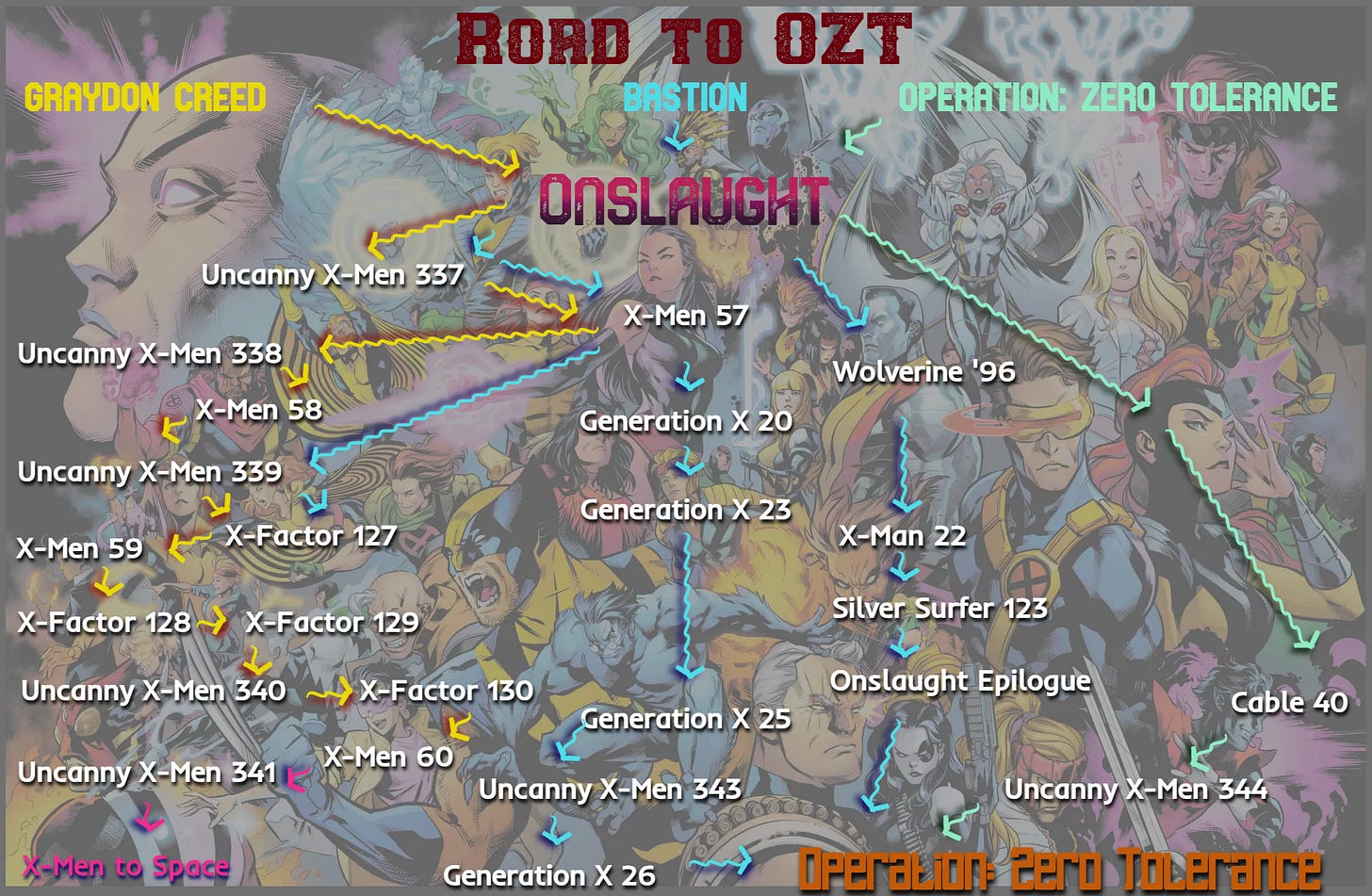Graydon Creed’s hate-based campaign may have ended when Creed himself was burned alive, but the forces arrayed against mutants march on.
Half of the X-Men were transported to the distant Shi’ar Empire at the end of Uncanny X-Men #341, and the space story that grows out of that is high octane from start to finish. But while terrestrial events proceed slower, they prove far more existential.
The following includes spoilers for Cable #40; Generation X #20, #23, #25-27; Uncanny X-Men #342-344; and X-Men #61-64.
It’s Back
The Legacy Virus makes a noteworthy return in the X-Men issues in a storyline that intersects with Kingpin’s time in Japan (the whole arc involves an X-Men alliance with Sebastian Shaw against Kingpin over an ancient healing compound known as the Elixir Vitae that might be able to cure the Legacy Virus). Kingpin’s presence in Japan is a by-product of stories going on elsewhere in the Marvel universe. His inclusion here feels out of place. Kingpin doesn’t have a long-standing connection to the X-Men or mutants in general. He also doesn’t have ties to Japan in the same way that the X-Men (and especially Logan) have. Inserting him between the X-Men and a cure for the virus feels like an attempt to give the underutilized Legacy Virus additional weight as a storyline.
The Legacy Virus was introduced at the end of X-Cutioner’s Song (though no one knew that at the time) and slowly started killing mutants. Its most high profile early casualty was Illyana Rasputin in Uncanny X-Men #303. Fabian Nicieza, the Legacy Virus’s creator, has stated that it came about out of a desire to do an AIDS related story in some way. Editors never allowed him to write one explicitly, so he used the Legacy Virus as a stand-in. Crediting it as an allegory for HIV and AIDS, though, is generous. For instance the Legacy Virus, as introduced, could not be transmitted to humans, and its method of transmission was unknown and unpreventable. The allegory works so far as the very early days of AIDS are concerned where medical knowledge about the disease was limited to non-existent. But even by the time the Legacy Virus was introduced, we knew how AIDS was transmitted and how to prevent its transmission. We also already had early treatments for HIV and AIDS that could extend life.
For quite a while the Legacy Virus just hung around in the background. Occasionally a high profile character would die from it (such as Jamie Madrox who died in X-Factor #100 but by the time of these X-Men issues had already been resurrected). Nothing equivalent to real world AIDS-related advances occurred in the comics. It wasn’t until X-Men Prime that the virus reared its head in a new way. The virus jumped to its first human, Moira MacTaggert. This might have given way to a greater emphasis on the danger of human infection not unlike the fear of heterosexuals being infected by the “gay cancer”. But even then, outside of Excalibur which featured Moira and took place at her science facility, this event largely fell by the wayside and its larger implications were ignored.
Kingpin’s intention with a Legacy Virus cure (assuming he can make one) is, of course, to sell it. This is the first real attempt to combine larger elements of the Marvel universe and a component of X-Men lore, the Legacy Virus, that should naturally impact them. Ultimately nothing comes of this storyline (which ends with the breakout of Operation: Zero Tolerance).
Do You Know Where Your Children Are?
Generation X serves as the chief vehicle for Operation: Zero Tolerance’s development. Instinctively, this sounds like a bizarre choice for an event that will run primarily through X-Men and Wolverine (Uncanny X-Men being lost in space, after all). But it actually makes a lot of sense. Even though headlining a major event wasn’t what Scott Lobdell had planned for the character, Bastion was still his creation. To this point, Lobdell was the only writer who had done anything significant with the character (Uncanny X-Men #333 and X-Men Unlimited #11).
Bastion’s first appearances in Generation X aren’t unlike his pop-ins in Wolverine, X-Factor, Cable, and X-Man (discussions of Silver Surfer will not be entertained). They consist of a page, maybe two. And he’s always gathering information in some shadowy location. In these cases, though, Bastion is actually running an investigation. One piece of information leads to another and then another. Rather than being ominous for the sake of being ominous, Bastion accomplishes what he sets out to do: he finds the child mutants at Xavier’s school.
The Secret Files
Cable #40 matters very little in the grand scheme of things. Moira MacTaggert sends Cable to rescue Renée Majcomb before Xavier’s files are lost completely and she becomes unreachable. It’s of note primarily for establishing that most of Xavier’s files were deleted during and after Onslaught and the rest are well on their way. This plot point will be all but ignored in later issues.
The Trials and Tribulations of Jubilation Lee
Until Cable #40, none of the X teams were forced into a conflict with Operation: Zero Tolerance. Even after Bastion's encounter with Rogue in X-Men Unlimited #11, it was unclear how much the writers believed Bastion knew about the X-Men (this was especially evident in Onslaught: Epilogue where Larry Hama waffled repeatedly on the subject). Even when his investigation begins in Generation X #20, Bastion's information seems somewhat contradictory--for instance knowing Banshee's identity and Chamber's codename but having no idea that the school was connected to the X-Men. Lobdell finally settles on Bastion knowing a great deal about the X-Men, something made clear in Generation X #27 when the event proper begins via the Jubilee plotline. Jubilee is on the run for her life in Generation X #25 after something goes wrong with Mondo. But Jubilee’s escape attempt brings her face to face with Bastion who takes her captive.
From here the series splits into three storylines leading up to and through the main event: Jubilee’s captivity at Bastion’s hands, Banshee and Emma searching for their students, and the students getting lost. Unfortunately, outside Jubilee’s brief story, Generation X’s involvement with Operation: Zero Tolerance reads as perfunctory (though not as much as with Onslaught where the issues felt like nothing more than a cash grab).
Part of this is likely a consequence of Lobdell’s departure from the series. There is an immediate tone change when James Robinson comes on as writer with the event already in progress (he fills in on #29-31), and his writing comes across as someone trying to get through an assignment as fast as possible. Simultaneous with the writing change, Chris Bachalo’s art style shifts drastically over the course of these issues (and Bachalo himself leaves after issue 31 with the series’ two creators focusing on other X assignments).
Lobdell has stated that he needed more time to focus on the two X-Men series which he was also writing. Bachalo left for Uncanny X-Men. Unfortunately, Generation X never recaptured the lightning that its creators brought to it. And ultimately neither man remained on the X-Men books past 1998.
If Operation: Zero Tolerance has a defined prologue, Jubilee’s story arc in Generation X #26-27 is it. Bastion spends the two issues interrogating and misdirecting the young mutant in an effort to learn more about the X-Men. There are several moments that offer hints pointing to who or what Bastion might be (though his origin isn’t revealed until the Cable/Machine Man 1998 annual). Jubilee’s characterization in these issues is a little scattershot as Lobdell seems to struggle with whether she is more of a student or more of an X-Man. This problem crops up from time after Phalanx Covenant when Jubilee, who has more experience than some X-Men, is shunted off to Generation X.
But now, with Jubilee being tortured for information, X-Factor gone underground, and all the X-Men out of the country (some of them very far out), is there anyone who can stand in the way of Operation: Zero Tolerance?
X-Men has never shied away from including a political component to their stories, so an anti-mutant presidential candidate makes a lot of sense. On its own this storyline probably wouldn't have any more punch than the average Senator Kelly screed. But combined with the promise of genocide (Creed actually uses the term "final solution" at one point) it takes on greater import. Alternate timelines have depicted horrible fates for mutants many times but at long last the threat is real.
Operation: Zero Tolerance’s opening issues are exciting. They pull no punches, and they set the X-Men back on their heels in a way that even Onslaught’s opening didn’t. The Flashback month is an unfortunate hiccup in the momentum generated by Generation X #27 and X-Men #65, and it reinforces that Operation: Zero Tolerance didn’t have the best planning.
Return to the Introduction here. Follow along with an issue-by-issue commentary at @theronscomics #XMenOZT.
Interested in following this series as new entries release? Manage your subscription below. New entries will be synced with issue commentary threads and likely follow a 1-2 post per week schedule.
What is good, everybody?
Thanks For Reading!
Do you find value in what I do here and on social media and want to support it? Please consider subscribing to these reviews or other posts.
If you really enjoy the content, you can also share it with others who enjoy comics!
And if you think you’ll be coming back often and want to help this grow , please consider donating. This is all driven by a love of comics, but it also takes a great deal of time and you can help it continue.
Thank you to everyone for your support.
If you like my comic content and are into video games, I do walkthroughs with detailed story analysis at Theron Plays Games.
Find my content all over the internet.




